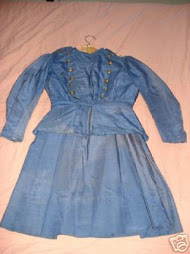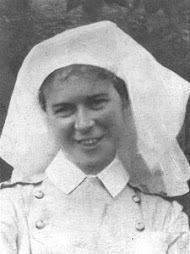Hello and season's greetings from Finding the Forty-Seven! I'm a bit late in posting my regular blog, but as Bob Cratchit told Ebenezer Scrooge in A Christmas Carol, "I'm behind my time, sir, but I've been making rather merry." I hope you have all been doing the same.
Today, I'd like to remember a nurse who survived the war, but who did not escape from the effects of war later in her life. My connection with this nurse began with two WWI uniforms that I purchased online. I bought the uniforms (one the smart dress uniform with it's matching cape, the other the "bluebird" working uniform that nurse's wore on the job) so that I could bring them with me when I gave talks about the nurses of the Great War.
I knew little, then, about the woman who had worn them. Her name was sewn into the back of each--"Cecile McKibben." Naturally, as a Great War researcher, I had to find out more about Cecile. I began with a foray into Ancestry.ca. I learned she was born in Glanford, Ontario, on August 2, 1883. She had red hair and green eyes. Her mother was German—Catherine Lois Hagel (her parents were Samuel and Ann Eliza Hagel) and her father was Scottish born George McKibben (son of Hamilton and Ascenath McKibben), a farmer. The pair was married on December 24, 1873 in the Weslayan parsonage in Ingersoll, Ontario. They would have four children—Lulu Kathleen (1875), Allie (1877), George (1879), and Cecile (1883).
George would die on October 11, 1885 of typhoid. This must have caused the family much hardship. Catherine is later listed as “farmer” on 1891 census returns, suggesting she kept the family farm going after George’s death. Her efforts cost her dearly. She would die on April 30, 1903, of pernicious anemia. She was only 51 years old.
It was clear that the McKibben children would have to make their own way in life. Cecile would become a nurse, studying in the United States. In July 1914, she is recorded as crossing the border of Duluth, Minnesota as a trainee nurse. I believe she attended the nursing school at the University of Illinois, as a Cecile McKibben appears as a nursing student there in 1914. Her last Canadian residence (before she completed her program) was recorded as Fort William, Ontario.
By 1917, Cecile had completed her studies and was living with her married sister Kathleen (Lulu) Wilkens in a solid two story brick home at 12 Somerset Avenue, Hamilton, Ontario. At this point, she had decided to serve overseas. With a limited number of nursing positions open in the Canadian Army Medical Corps, she opted to join the British nursing service (the QAIMNS) first and transfer to the Canadian service later.
Fortunately, I discovered that Cecile’s records with the QAIMNS have been preserved (very lucky, since many had been weeded or lost). They reveal a great deal about her character. She joined the QAIMNS in March 1917 and served until March 1918. During that time, she was stationed in France, in #13 General Hospital (8 months) and in #14General Hospital (4 months).
During her time with the British nursing service, Cecile seems to have had some run-ins with the senior nursing staff who report that she was not “energetic or keen about her work in the wards.” At the time of Cecile’s resignation from the QAIMNS in 1918, Matron Fox of #14 General reports in February 1918 that “I would not recommend that Miss C.L. McKibben’s services should be retained in the QAIMNSR even should she wish to continue serving. Her work has not improved since my report to the effect that she did not appear to take any interest in her work or her patients.” This is very damning criticism, however we are fortunate to have Cecile’s own version of events. A month earlier, she had written to Matron Fox: “Madam: I have the honor to request that I may be allowed to resign on the termination of my contract [nurses in the QAIMNS signed up for one-year-at-a-time contracts] on March 7, 1918. My reason for doing so is that I wish to join a nursing service in which I shall have more freedom, more privileges and better pay. I have the honor to be madam, Cecile L. McKibben, Staff Nurse, QAIMNSR.”
Canadian nurses did have more freedom (they could date other officers and socialize more freely than British Army nurses) and they were paid the same as other lieutenants in the Canadian military (they had true military rank—something no other military nursing service of this time had). The correspondence clearly indicates a conflict between Cecile and her superiors. It raises some interesting questions: Did Cecile perhaps have a romance going on at this time? (She met her future husband George MacKenzie while nursing.) If so, it would have been a breach of her contract with the QAIMNSR. Or did her German background come to light (many Britons and Canadians were German-phobic at this time) and as a result, Cecile was poorly treated by other nurses? Or was her nursing work not up to par? It is hard to know, but my feeling is that she seems to be a strong-willed character and that may simply have led to some challenging moments.
In March 1918, Cecile entered the Canadian Army Medical Corps. I was able to get her records in the Canadian service from the national archives. (Anyone can do this. You go to http://www.collectionscanada.gc.ca/index-e.html. Then click "ancestors" in the upper right hand corner, then go down to "soldiers of the first world war." Click this--it will take you to a page where you can put the name into the search engine and inevitably, you will find your nurse or soldier.)
I ordered her complete file (the website only gives you the first two pages). Her records listed her as being 5’3” tall and 125 pounds—dropping to 120 by the end of the war, with a “good physique.” She must have been very tiny, since the uniform that I own will only fit on the smallest size possible on my dressmaker’s dummy. Cecile also wore glasses. She would serve with the No.15 Canadian General, the Duchess of Connaught Canadian Military Hospital, and No 10 Canadian General. In 1919, at the end of the war, she would catch (and survive) the Spanish flu. She would also suffer a breakdown—what doctors then called “neurasthenia” and what we now call “post-traumatic stress disorder.” This was not unusual for nurses at the time—many suffered from being witnesses to terrible trauma and loss.
Sometime during her service in France or England, she met George Fraser MacKenzie, a farmer from Spirit River, Alberta. He had enlisted in 1916 and was serving as an ambulance stretcher bearer. George was muscular, 5’7” tall, with gray eyes and brown hair and was eight years younger than Cecile. He had been wounded and Cecile seems to have been his nurse. [This bears future research.] George and Cecile were married on November 11, 1919, the first anniversary of the end of the Great War.
In their years together, Cecile was active in the local United Church, participating in the Ladies Aid, and playing the organ for many years. George was on the school board and Spirit River Municipal Council. One older lady described Cecile as a sweet woman with a very strong belief in her own rightness, and George as gruff. They had two children, Hugh born in 1922 and Virginia Lois born in 1924. The children attended White Mountain School and the Spirit River High School. As Lois wrote: “Like other country children who lived more than four or five miles from Spirit River, they lived on their own during the week, and went home on weekends.” The two were very close and there are many pictures of them in the Spirit River history book—smiling, attractive young people.
During WWII, George enlisted in the air force in 1941, and the farm was rented out. In 1942, when Hugh and Lois graduated from high school, Cecile joined George in Ontario, while Virginia went to Normal School, then joined the Air Force a year later. Hugh became a navigator and was killed in action over Germany in 1944. The couple who had survived the rigors of the First World War, could not escape suffering a terrible loss in the Second.
Cecile came home after that tragedy and George joined her a year later and they resumed farming. Virginia was discharged in 1945, taught at White Mountain School, and then went to the U of A on a soldier’s grant, receiving her MD in 1953. In 1954, Cecile died after a short illness. She is buried in White Mountain Cemetery. George farmed until 59, and then moved in with Virginia and her husband George Sawers until MacKenzie’s death in 1977. According to George Sawers, the MacKenzie’s kept loads of their souvenirs of WWI (from cots to uniforms to clothing)—the war they couldn’t ever forget.
So that is the tale of my uniform and the woman who once wore it. Next month I will return to commemorating nurses who lost their lives in the First World War. Until then, I wish you the best of the season!
Subscribe to:
Post Comments (Atom)






















Hope you had a great holiday season as well and just wanted to congratulate you on being voted one of the top nursing blogs of 2011! Just in case you where not not aware of it, here is the post: http://www.resumeservicesonline.com/blog/resume/top-36-nursing-blogs-to-help-with-your-nursing-career/
ReplyDeleteOh, that uniform of Cecille is small and yet very historic. :)
ReplyDeleteThanks for sharing,
Peny@lab coat